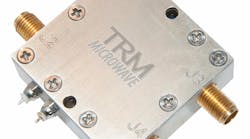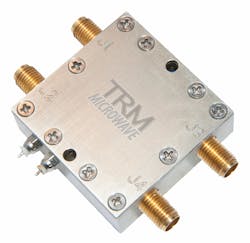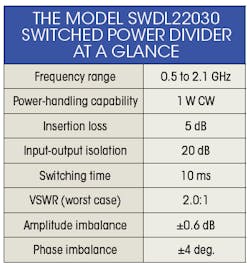Integration is one key to miniaturization, and it was the design path chosen for the model SWDL22030 RF/microwave power divider from TRM Microwave. The compact power divider, which operates from 0.5 to 2.1 GHz, incorporates a 3-dB power divider with an integrated single-pole, double-throw (SPDT) fail-safe switch on the input port. The end result is a single, compact unit that combines two important system functions: signal switching and power division. By combining these two functions into a single unit, TRM has simplified system design, saved space, and demonstrated custom design/fabrication capabilities.
The SWDL22030 was originally designed for use in a Global-Positioning-System (GPS) application, but this broadband design can be used in any application requiring user-controlled power division and signal routing between antennas and receivers. The SWDL22030 is capable of maintaining its specified performance levels over a wide temperature range, which enables it to be used in high-altitude applications. It includes a DC-blocked RF signal path and a DC-pass RF path for system flexibility.
The SWDL22030 (see figure) combines two high-frequency component functions within a small package measuring just 1.5 x 1.5 x 0.100 in., with four RF connectors and two DC pins. It also provides users with two traditional component functions that are now impedance matched and optimized for performance when working together—and without the usual problems that can plague passive high-frequency components when tying them together, such as amplitude and phase imbalances. The SWDL22030 achieves impressive impedance matching between the switch and the power divider, which allows for a typical amplitude imbalance of ±0.6 dB and a typical phase imbalance ±4 deg. across the full 500-to-2100-MHz frequency range (see table).
The SWDL22030 has less than 5-dB across its full frequency range, which is a combination of the separate insertion losses for the power divider and the fail-safe switch. The SWDL22030 exhibits a typical input/output VSWR of 1.50:1 across the full frequency range, and maximum VSWR of 2.0:1. Minimum isolation between the output ports is 18 dB, and 20 dB from input to output ports. In terms of handling power, the SWDL22030 is rated for continuous-wave (CW) input power levels as high as 1 W (+30 dBm).
In use, the SWDL22030 provides two 50-Ω input and two 50-Ω output coaxial ports, with female SMA connectors. One pair of the input and output connectors provides the DC pass path and one pair forms the DC blocked path. The internal switch features 10 ms switching speed and can pass as much as 0.5 A current through the RF contacts. The switching function is controlled via voltages of 18 to 32 V, with maximum switch control current of 0.060 A. Soldered posts are used as the switch’s control connectors.
For system applications requiring selective inputs for two simultaneous outputs (i.e., a selected transmitter splitting its signal and feeding two antennas at the same time) and/or two simultaneous inputs switched to one of two outputs (i.e., two antennas combining and feeding a selected receiver), the SWDL22030 provides the means to achieve that function. It also can simplify system design and save space. It is usable across operating temperatures from -55 to +85°C and, without the interface issues of separate components, should maintain performance under rugged environmental conditions, and without the interface issues usually encountered with separate components.
TRM Microwave, 280 South River Rd., Bedford, NH 03110; (603) 627-6000.


